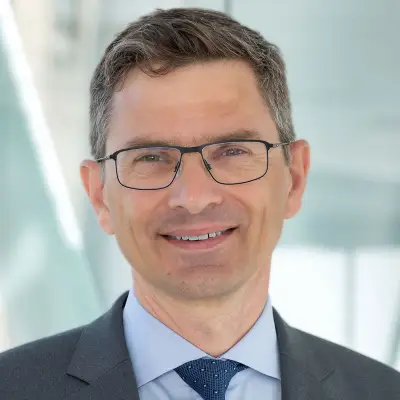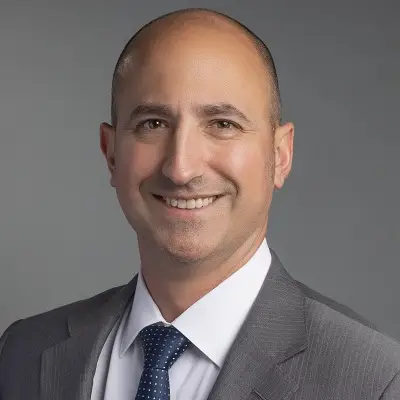The Robotic Cardiac Surgery Program at NewYork-Presbyterian and Columbia recently hit a major milestone by performing more than 100 robotic heart surgeries in its first year. This current pace makes it one of the highest volume centers in the country, allowing more patients to have access to a procedure that is less invasive than traditional open heart surgery and offers a faster recovery.
The robotic program, which launched in September 2023, has been a key addition to NewYork-Presbyterian and Columbia’s cardiac surgery services. “By offering these robotic procedures, you have a really comprehensive program that covers everything across the spectrum of cardiac surgery and the treatment of cardiovascular disease,” says Arnar Geirsson, MD, director of the Cardiovascular Institute and the Surgical Heart Valve Program at NewYork-Presbyterian and Columbia.
The robotic approach is becoming increasingly popular with patients, Dr. Geirsson says, because it offers better cosmesis with only a few small incisions. The procedure typically also has less pain and bleeding, uses fewer blood products, and decreases the length of stay in the hospital. Most patients can return to daily activities, such as driving, in just two weeks.
For surgeons, one of the key advantages is the enhanced visualization of the cardiac structures, which allows for superior repairs in cases like mitral valve repair or replacement.
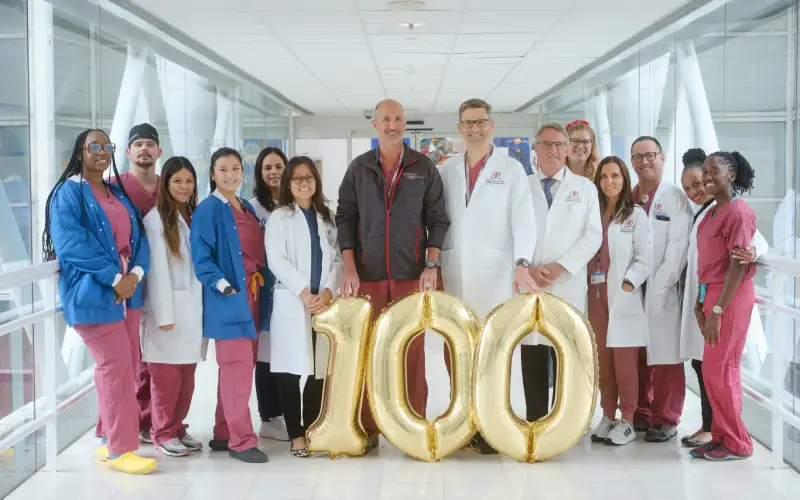
Michael R. LaLonde (left center) and Dr. Arnar Geirsson (right center) surrounded by the Robotic Cardiac Surgery team.
Building From the Ground Up
Dr. Geirsson, who is a pioneer in minimally invasive and robotic cardiac surgery, and Michael R. LaLonde, MHA, PA-C, director of the Robotic Cardiac Surgery Program at NewYork-Presbyterian and Columbia, are long-time collaborators and were instrumental in the advancement of the new center. The pair previously worked together for 15 years at Yale New Haven Hospital, where they spearheaded robotic cardiac surgery development, performing hundreds of mitral valve procedures over the years.
In fall 2023, Dr. Geirsson and LaLonde joined NewYork-Presbyterian and Columbia, adding their extensive experience with robotics to the internationally recognized heart valve program. Upon joining, NewYork-Presbyterian created a Robotic Surgery Task Force, with representation from various parts of the hospital, including members of the executive leadership team, OR leadership and nursing, the cardiothoracic intensive care unit, and the central sterile processing department. This buy-in from senior leadership and the multidisciplinary collaboration helped create the conditions for success, LaLonde said.
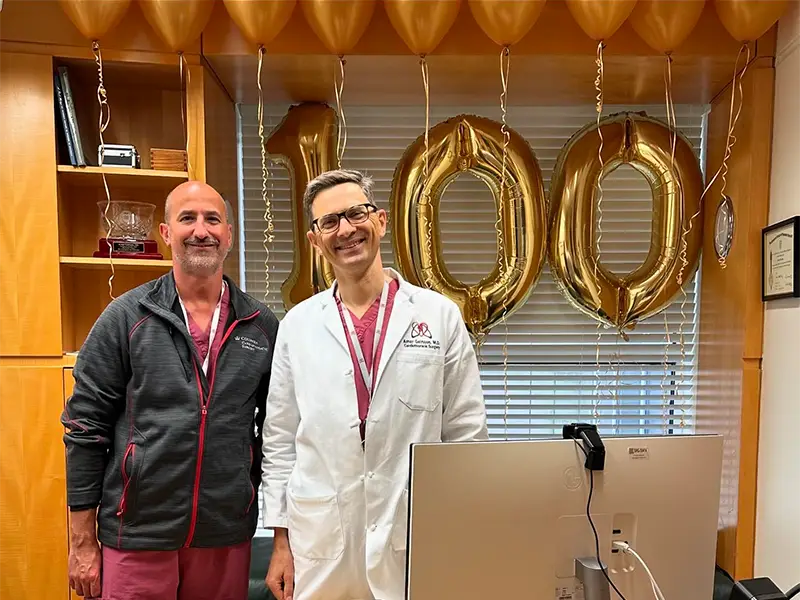
LaLonde and Dr. Geirsson celebrate their 100th procedure milestone.
The hospital dedicated a robot to cardiac procedures and assembled a dedicated team of OR nurses and surgical technologists who help perform every operation. Along with anesthesiologists & perfusionists who were trained in robotic operations.
Our very first case went off without a hitch. I think we were very well prepared and had everything we needed.
— Michael R. LaLonde
In the run up to the first case, the OR team underwent simulation training and a “dry lab” where Dr. Geirsson & LaLonde walked them through possible cases, the various disease processes, and answering questions. They also spent time streamlining the surgical processes, even creating custom instrument trays for the procedures. All these steps were critical to enabling success.
The first case, a mitral valve repair, was performed on September 12, 2023. “Our very first case went off without a hitch,” LaLonde says. “I think we were very well prepared and had everything we needed.”
Patient Outcomes and Selection
While the original goal for the first year was to perform 50 robotic surgeries, the volume of cases quickly ramped up. Dr. Geirsson said the rapid uptake was a combination of word spreading about the procedure’s excellent outcomes and the reputation of NewYork-Presbyterian and Columbia. “The reputation here is such that when you offer a treatment that works well and has good results, the referrals come,” he says. “It’s a great institution where everyone is working toward innovation.”
The majority of the program’s surgeries have been mitral valve repair for patients with mitral valve regurgitation, but the procedure is also appropriate for many other cardiac conditions, including tricuspid valve repair and replacement, atrial fibrillation ablation, atrial septal defects, cardiac tumors, and congenital cases, according to Dr. Geirsson. There have been no deaths, strokes, or other major complications among the first 105 surgeries, and the average length of stay in the hospital was just four days.
“The robotic surgery has been associated with great results, both from a safety standpoint and the ability to repair the valve,” Dr. Geirsson says.
Dr. Geirsson estimates that 5% to10% of patients who come to see him for robotic surgery end up having a contraindication and therefore require sternotomy approach.
While many patients could be candidates for a robotic approach, careful patient selection is critical. All patients are evaluated using screening CT scans before surgery to investigate potential contraindications, such as severe atherosclerotic disease or heavy mitral calcification. But Dr. Geirsson estimates that 5% to 10% of patients who come to see him for robotic surgery end up having a contraindication and therefore require sternotomy approach.
Overall, the team is “aggressive but safe” in selecting patients who could undergo the procedure safely, LaLonde says. For instance, while some programs shy away from operating on patients with a high body mass index, LaLonde says those patients can often benefit the most since the robotic procedure allows for smaller incisions, avoiding issues with wound healing that can be more complex in patients who have obesity.
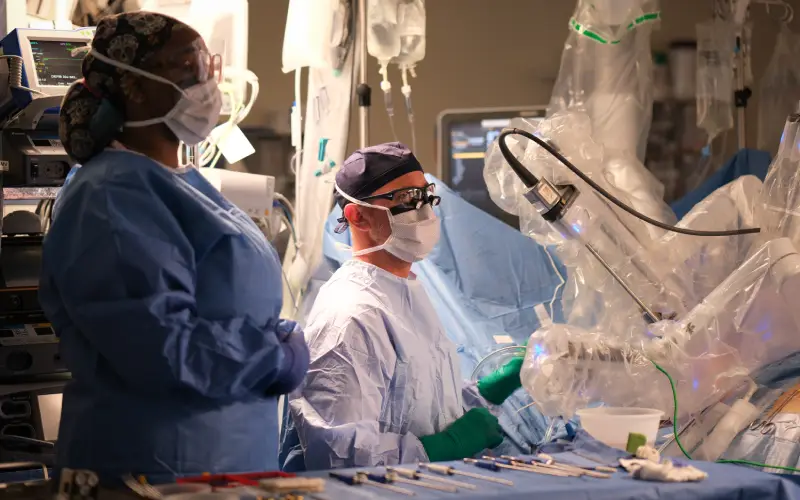
Surgical tech, Sha Paris Mullings (left) and LaLonde (right) bedside during robotic procedure.
Looking to the Future
In addition to adult cases, the team also performed two pediatric surgeries this year, with the youngest patient being six years old. In both cases, the robotic approach was successful on patients who had large atrial septal defects that were not amenable to percutaneous closure. With the addition of pediatric services, NewYork-Presbyterian and Columbia has become one of the few centers in the United States offering robotic cardiac surgery to children.
Robotic cardiac surgery shouldn’t be something unique. There’s no reason why 20% or even 25% of cases done in cardiac surgery shouldn’t be done with a robot.
— Dr. Arnar Geirsson
Moving forward, Dr. Geirsson will be partnering with colleagues who are experts in congenital heart surgery to build out a pediatric robotic cardiac surgery program. While not all cases are appropriate for the robotic approach, Dr. Geirsson says there are significant advantages for children because they won’t go on to have large scars on their chests. Additionally, the robot allows the surgeon to have greater visibility and maneuverability when operating on a smaller patient, allowing for a safe operation.
Another mission is to train a cadre of future robotic cardiac surgeons. While all the surgeries done to date have been performed by Dr. Geirsson, several surgical residents have been able to assist on the surgical robot.
Training of more robotic cardiac surgeons is essential, Dr. Geirsson says, because the access to the approach must be expanded. “Robotic cardiac surgery shouldn’t be something unique,” he says. “There’s no reason why 20% or even 25% of cases done in cardiac surgery shouldn’t be done with a robot.”




